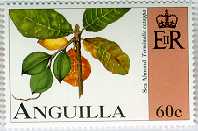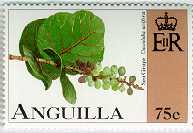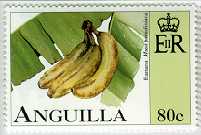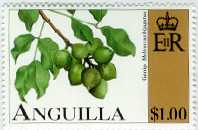
The Sea Almond is generally grown domestically, but is also known to survive harsh conditions. The fruit ripens yellow or pinkish red and the thin skin and fiberous pulp are eaten.
The trees can attain a height in excess of 40ft.

The pristine, white sand beaches of Anguilla are lined with the shady Sea Grape trees. The plant, which is also found inland, produces a berry-like fruit which turns dark purple when ripe.
The Sea Grape is a specialty among islanders and is harvested
during summer. The grapes are generally eaten as harvested or
can be made into preserves or wine.

On Anguilla, the Banana is grown domestically on a limited scale. The plant requires a maximum supply of water for effective growth, therefore constant irrigation is supplied from drain pipes or other sources of waste water.
Grown as a cash crop by other Caribbean and Latin American countries, the Banana is one of the regions' more popular fruits.
The tasy fruit is generally eat unprocessed but is widely used
in a variety of recipes including the famous Banana Nut Bread.

The bowers of Anguilla's many Genip trees become the haunt of carefree children during the long summer days when the fruit is in abundance.
The Genip, which grows in clusters, vary in size, shape and
taste from tree to tree. The fruit, high in acidity, range from very
sweet to extremely sour, and are eaten as they are harvested.
The sweeter varieties may be sold locally.
Fruits of Anguilla- Part 3
Back to "Stamps of Anguilla"